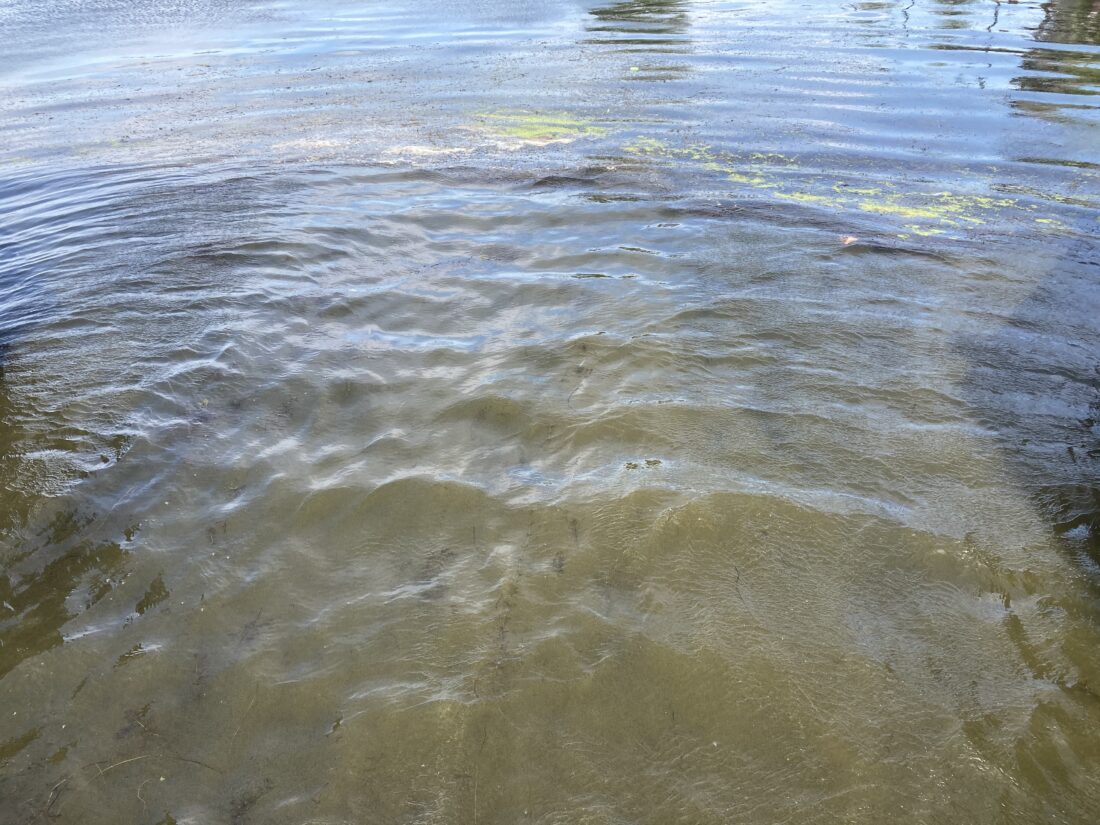What’s Causing Harmful Algae Blooms On Chautauqua Lake?
To Preserve And Enhance

Alage in Chautauqua Lake. Photo by John Jablonski
We are now in the middle of the summer recreational season on Chautauqua Lake, and lake algae and plants are topics of discussion by many.
A recent conference organized by Chautauqua Institution highlighted ongoing research on the lake which shed some light on the conditions that facilitate harmful algae (Cyanobacteria) blooms. Attendees learned about research by Rensselaer Polytechnic Institute/Freshwater Institute and IBM scientists as part of the Jefferson Project, SUNY-College of Environmental Science and Forestry, Syracuse University and State University at Fredonia researchers.
Cyanobacteria, the group of organisms that can produce toxins in freshwater lakes such as Chautauqua, is one of several organisms that make up phytoplankton, the base of the food chain in our lakes along with plants. Most phytoplankton, composed of diatoms, algae, Cyanobacteria and other organisms which perform photosynthesis, are beneficial and essential to the ecology of our lakes and the food web fueling our lake fisheries.
Chautauqua, being a shallow lake with its watershed made up of glacial soils containing relatively abundant phosphorus, is naturally and historically a fertile lake. The lake’s watershed, which had been almost entirely forested, was nearly all cleared for farming in the 1800s. This clearing exposed the watershed soils to accelerated erosion and deposition of topsoil into the lake. This, coupled with loading the lake with poorly or partially treated sewage and farm runoff for decades and decades, has significantly enriched the lake sediments.
Algae need sufficient concentrations of nutrients, suitable temperatures and sufficient light to grow. Presenters at the conference noted that weather patterns and temperatures are changing due to climate change and are leading to conditions more conducive to the development of Cyanobacteria (“harmful algae”) blooms. More frequent severe rainfall events can increase the flush of nutrients and other pollutants into the lake, whichfuel algae blooms. Rising temperatures of lake surface waters can cause more frequent stratification of lake waters, facilitating the release of phosphorus from sediments into the lake’s water column. During periods of low wind and calm waters, Cyanobacteria (formerly called blue-green algae) can descend to absorb phosphorus from deeper waters and ascend to near the lake surface to absorb sunlight to grow and multiply. Strong wind-driven wave action and currents impede Cyanobacteria from their vertical movements and concentrating into “scums.” Researchers noted last summer that a Cyanobacteria bloom in the south basin was associated with a large runoff storm event a few days earlier bringing watershed nutrients into the lake and detected Cyanobacteria blooms associated with release of phosphorus from sediments in both north and south basins. The concentrated phosphorus in the sediments has been accumulating from watershed runoff and wastewater for decades. It was also noted that zebra mussels, which invaded the lake in the 1990s, appear to exacerbate the incidence of harmful algae blooms.
One researcher concluded that, while locally we can’t control climate change, increased storm events or warming lake surface temperatures, we can control the nutrient pollution coming from the land cover and land uses in the watershed – which address the nutrient loading coming into the lake now and into the future. Governments are coming together to sewer the majority of the unsewered lake shorelands and have upgraded wastewater treatment plants to significantly reduce phosphorus loading to the lake.
What is left to do is to conserve and restore the health of the watershed to trap, store and filter precipitation and runoff before it reaches the lake and its tributaries. Greg Boyer, Ph.D, SUNY-ESF Emeritus Professor highlighted the CWC’s and Chautauqua Institution’s LakeScapes program with the growing number of lakeshore buffers on the lake shoreline, noting it as an important way to keep nutrients from reaching the lake.
Multiple avenues of research on this lake and its tributaries are again underway this summer with the goals of giving lake and watershed organizations, governments and citizens more information on what factors facilitate harmful Cyanobacteria blooms (HABs) and, ultimately, what actions can be taken on land and in the water to manage the sources of the nutrients and factors driving such blooms. In the meantime, CWC encourages you to take action personally on your property to reduce your pollution to this lake. Visit the CWC Facebook page, Instagram page or website to learn more about what you can do to get on board for clean and healthy lakes.
The Chautauqua Watershed Conservancy is a non-governmental not-for-profit organization primarily funded by membership donations and private grants. Its mission is to preserve and enhance water quality, ecology and scenic beauty of the lakes, streams and watersheds of the Chautauqua region.




